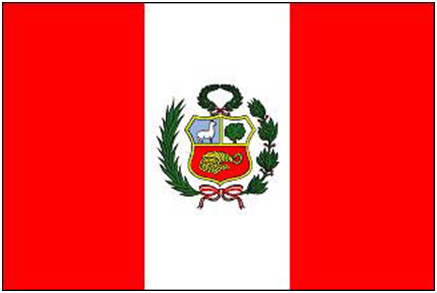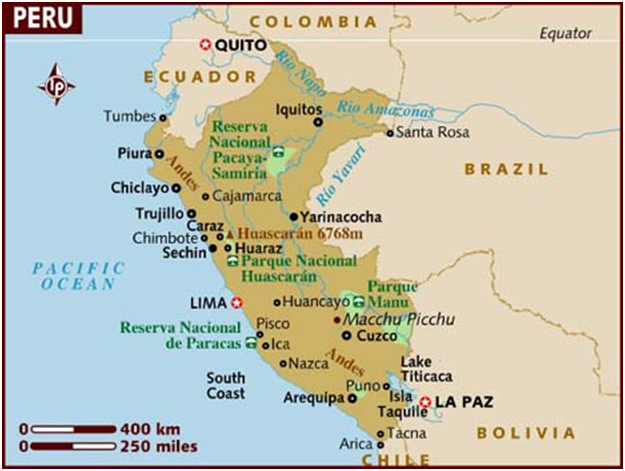| PERU |
 |
|
Formal
name in Spanish: Republica del Peru
Capital: Lima
Head of government: President Ollanta HUMALA Tasso
Languages: Spanish
Surface area: 1,285,220
km2
Currency: Peruvian Nuevo
SolPopulation: 29,849,303 (2013 est.)Labour force:16.2 million
GDP: US$325.4 billion (2012 est.)
GDP per Capital: US$10,700 (2012 est.)
GDP Growth Rate:
6% (2012 est.)Inflation: 3.6% (2012 est.)
Main economic sectors: Copper, Gold, Zinc, Oil and products, other minerals.
Main export commodities: copper, gold, lead, zinc, tin, iron ore, molybdenum, silver; crude petroleum and petroleum products, natural gas
Main export partners: China, US, Canada
Value of Exports: $47.38 billion (2012 est.)
Largest companies (take from top 500 ranking):REPSOL YPF PERU, MINERA ANTAMINA, SOUTHERN
PERU COPPER CORP, PETROPERU, TELEFONICA
DEL PERU, MINERA YANACOSHA, BARRICK MISQUICHILCA,
DOERUN PERU
Top business schools: CENTRUM-PUC,
ESAN, USIL, U. LIMA
Poverty: 31.3% (2010 est.)
Education (% of young people in higher education):
35%
Human development index (2008): 0.788 (79TH)
Energy consumption: 0.613
Quadrillion BTU
Sources of energy: oil
(38%), gas (41%), hydropower (21%)
(Source: CIA, The World Factbook) |
|
|
|

| COUNTRY
BRIEF |
Peru's economy reflects its varied geography - an arid lowland coastal region, the central high sierra of the Andes, the dense forest of the Amazon, with tropical lands bordering Colombia and Brazil. A wide range of important mineral resources are found in the mountainous and coastal areas, and Peru's coastal waters provide excellent fishing grounds. The Peruvian economy has been growing by an average of 6.4% per year since 2002 with a stable/slightly appreciating exchange rate and low inflation, which in 2013 is expected to be below the upper limit of the Central Bank target range of 1 to 3%. Growth has been in the 6-9% range for the last three years, due partly to a leap in private investment, especially in the extractive sector, which accounts for more than 60% of Peru's total exports. Despite Peru's strong macroeconomic performance, dependence on minerals and metals exports and imported foodstuffs subjects the economy to fluctuations in world prices. Poor infrastructure hinders the spread of growth to Peru's non-coastal areas. Peru's rapid expansion coupled with cash transfers and other programs have helped to reduce the national poverty rate by 23 percentage points since 2002, but inequality persists and continues to pose a challenge for the new Ollanta HUMALA administration, which has championed a policy of social inclusion and a more equitable distribution of income. Peru's free trade policy has continued under the HUMALA administration; since 2006, Peru has signed trade deals with the US, Canada, Singapore, China, Korea, Mexico, Japan, the European Free Trade Association, Chile, and four other countries; concluded negotiations with Venezuela, Costa Rica, and Guatemala; and begun trade talks with two other Central American countries and the Trans-Pacific Partnership. Peru also has signed a trade pact with Chile, Colombia, and Mexico called the Pacific Alliance that rivals Mercosur in combined population, GDP, and trade. The US-Peru Trade Promotion Agreement entered into force 1 February 2009, opening the way to greater trade and investment between the two economies. Although Peru has continued to attract foreign investment, political activism and protests are hampering development of some projects related to natural resource extraction.
(Source: CIA, The World Factbook) |
|











